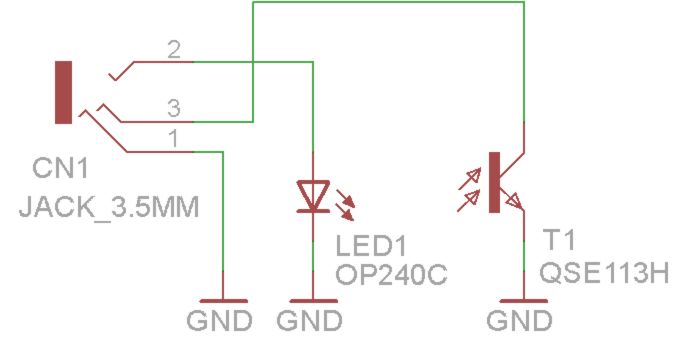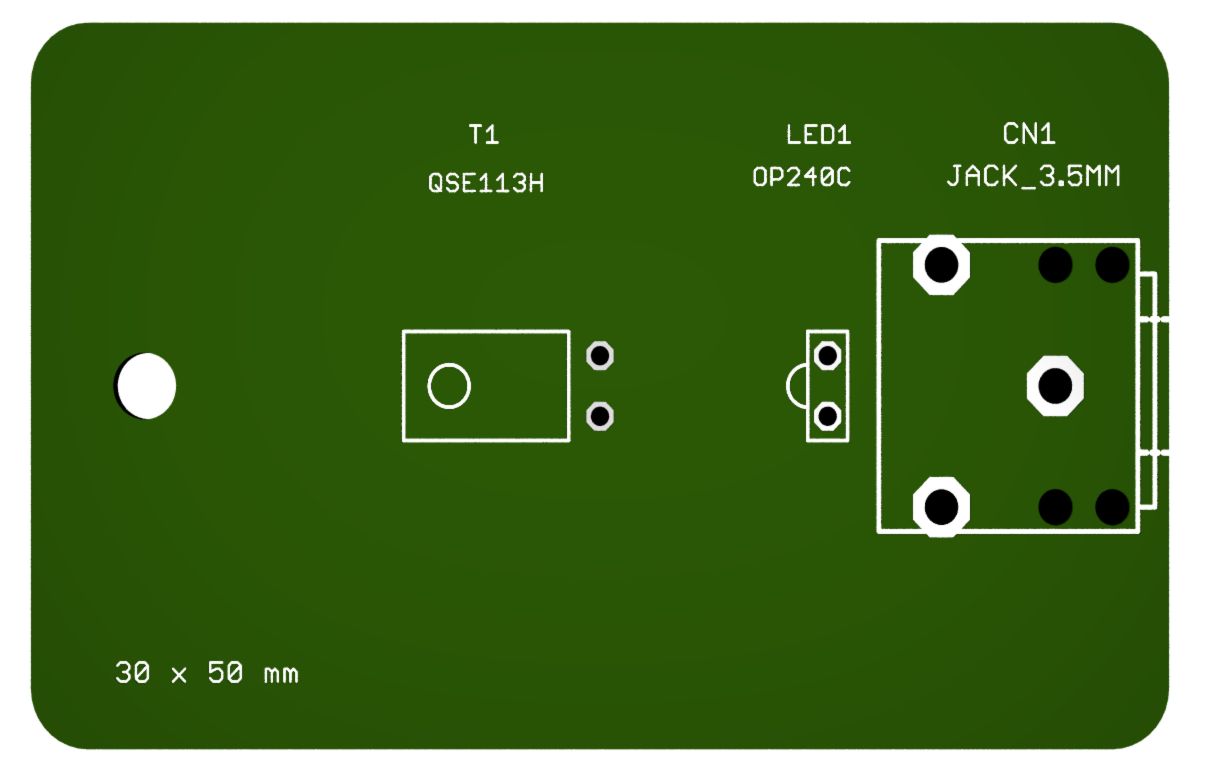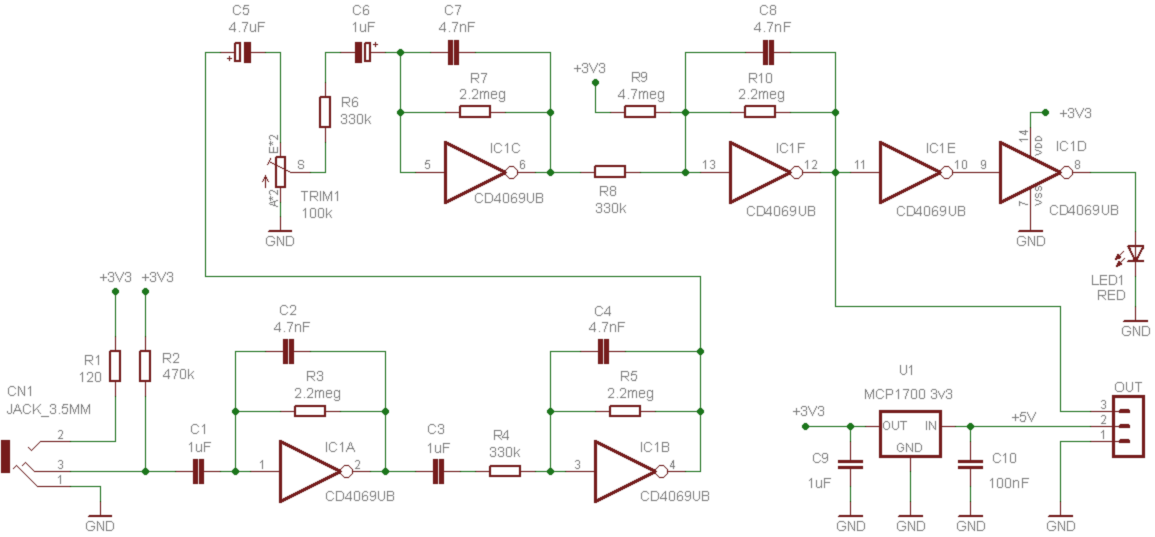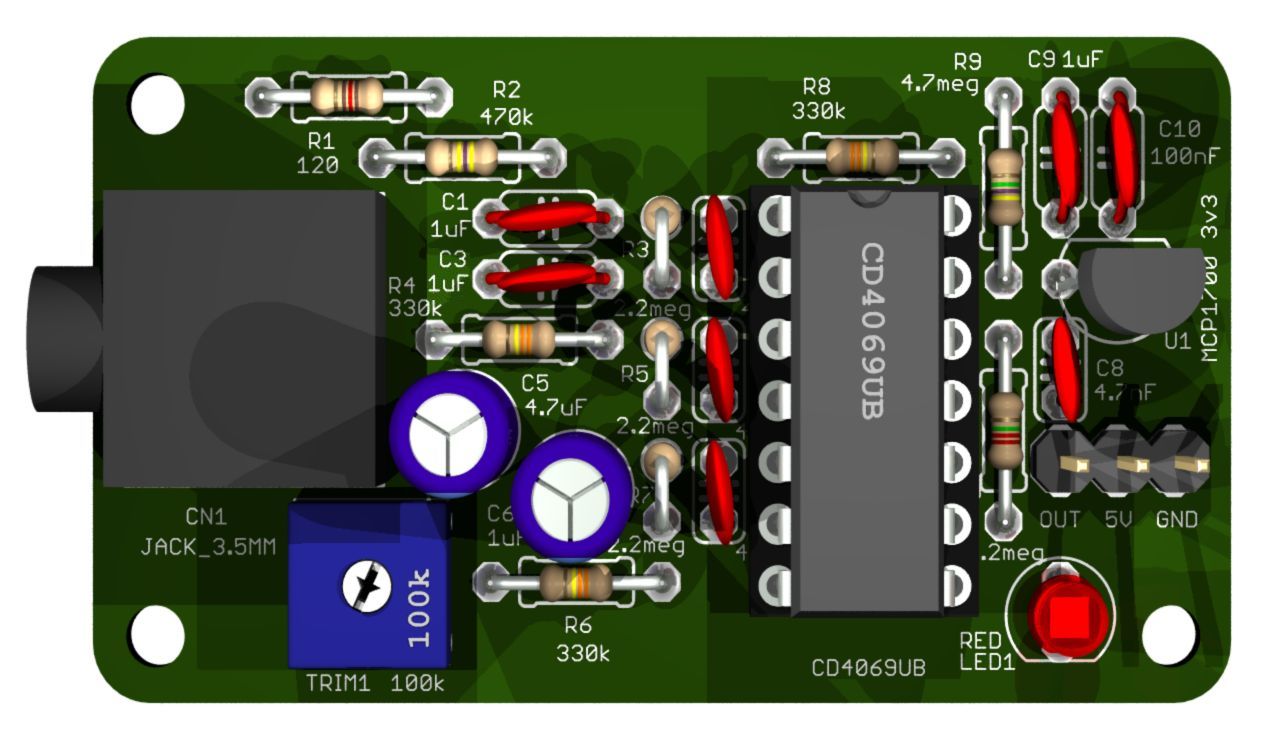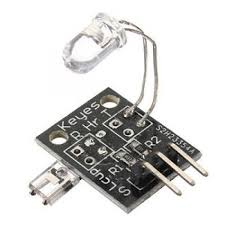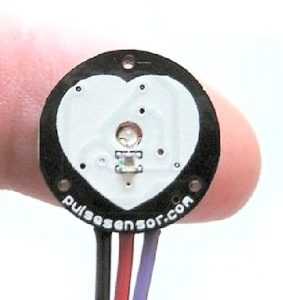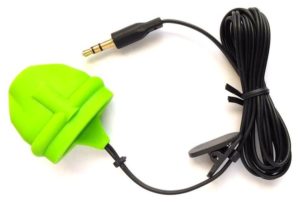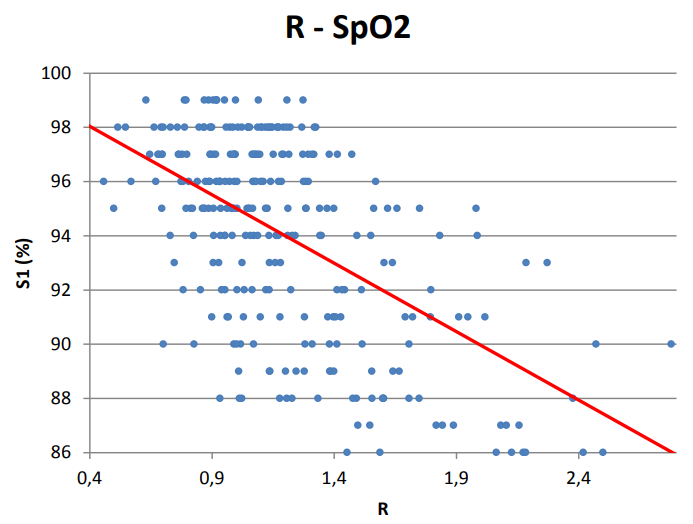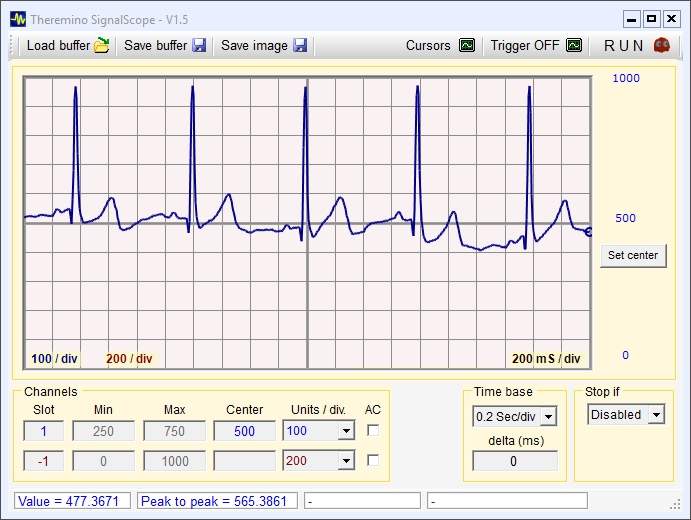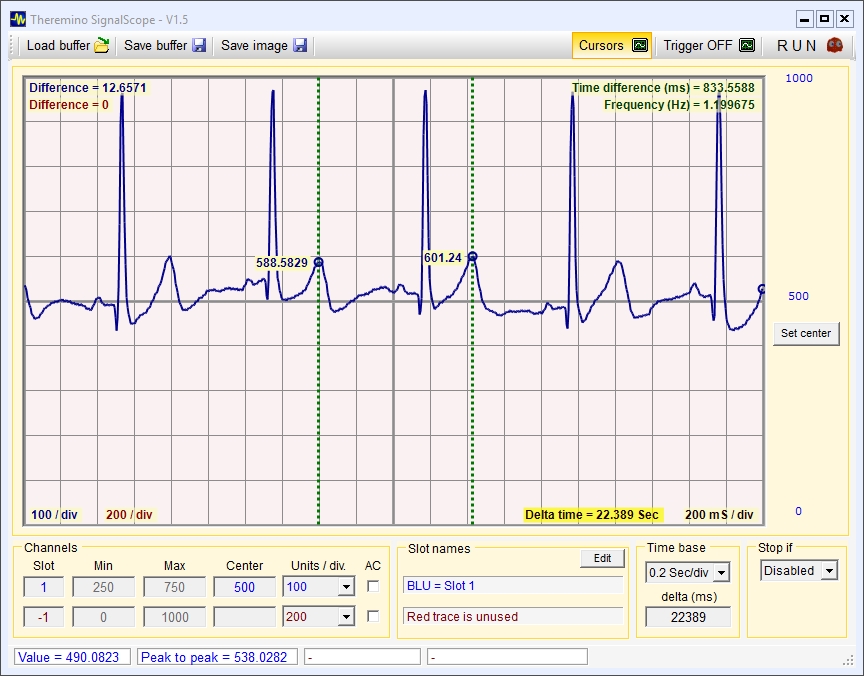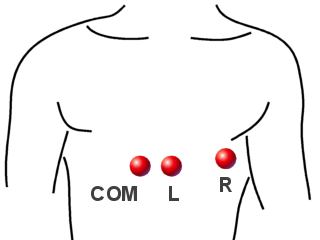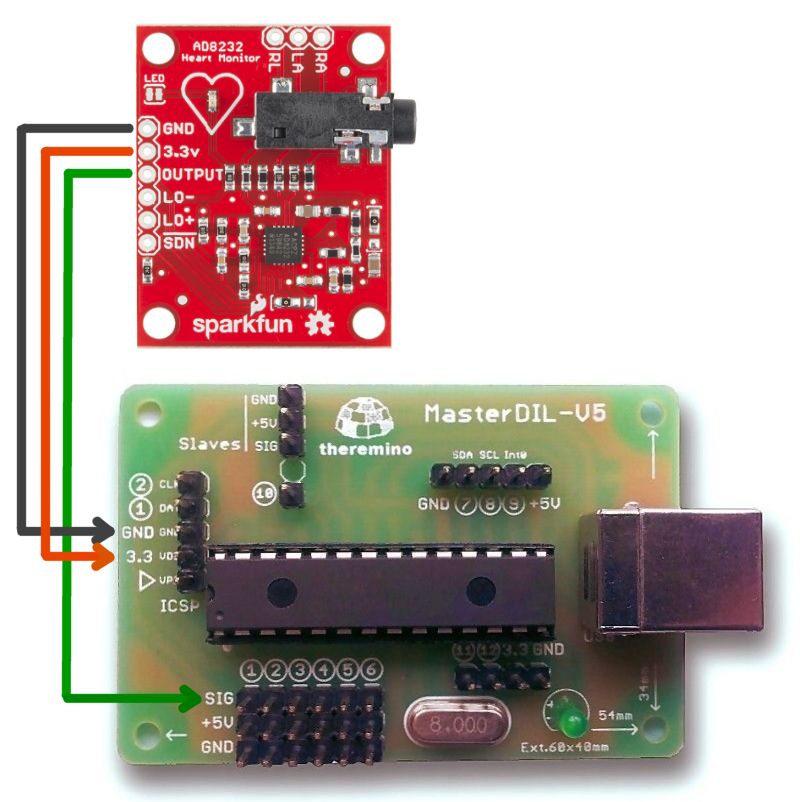Sensore per OCG
Un sensore OCG (Nota 1), da applicare su un dito può fornire più informazioni di quel che si pensa normalmente. Oltre alla frequenza cardiaca si possono osservare le aritmie e classificarle nei principali tipi. Si possono anche osservare gli effetti della bassa pressione sulla ampiezza del segnale e persino le variazioni periodiche della frequenza cardiaca causate dalla respirazione.
(Nota 1) Il nome esatto per la rilevazione ottica sarebbe “photoplethysmography” ma è difficile da ricordare e anche mal composto. Dato che si rilevano variazioni ottiche invece che elettriche, l’equivalente di “Electro” non è “PhotoPlethysmo” ma “Optical” e quindi da ora in poi lo chiameremo OCG.
Le aritmie sono molto frequenti, ad esempio le “Contrazioni ventricolari premature” si verificano nella maggior parte delle persone in varie occasioni (maggiori informazioni qui). Nella gran parte dei casi non ci si deve preoccupare e non sono consigliate terapie, ma non sarebbe male poter dare una controllatina tutte le volte che si hanno delle sensazioni strane. Il metodo che proponiamo con questo sensore e con la applicazione Theremino ECG è il più indicato per frequenti controlli da fare a casa.
Le aritmie spesso non causano sintomi. Ma si può sentire una strana sensazione nel petto, come ad esempio:
- Palpitazioni
- Peso al petto
- Tuffo al cuore (spesso descritto così dai pazienti)
- Una maggiore consapevolezza del battito cardiaco
- Sensazione di battito mancante
Molti di noi hanno avuto queste sensazioni e quasi nessuno è andato a fare un ECG per controllare. Per fare un ECG bisogna prenotarsi, ci vogliono ore ed è quasi certo che nel breve tempo dell’esame non si osserveranno eventi significativi. Lo dice la legge di Murphy ma è anche dovuto al fatto che un ECG viene fatto in orari, ambienti e stati mentali diversi da quelli che potrebbero generare aritmie.
Invece con questo strumento si possono fare test comodi e veloci. Non servono elettrodi, pasta conduttiva, cerotti e alcool, basta il dito indice e pochi secondi di tempo. Se poi appare qualcosa di strano si andranno a fare gli accertamenti. Ma si andrà sul sicuro e si disporrà di qualcosa di concreto, non solo sensazioni e parole. Quando si andrà dal proprio medico e poi dal cardiologo, gli si potranno mostrare stampe su carta dei tracciati che contengono le aritmie. Oppure portare il Tablet e fargli scorrere all’indietro nel tempo un grafico registrato. Alcuni medici potrebbero rifiutare queste informazioni perché non provengono da esami ufficiali, in tal caso cambiate medico. Non fidatevi a mettere la vostra vita in mano a persone così ottuse da non saper riconoscere dati utili quando li vedono.
Non scriveremo qui le solite frasi tipo: “non fidatevi di voi stessi”, “fidatevi solo della medicina ufficiale”, anzi vi esortiamo a cambiare atteggiamento verso la medicina e a non delegare ad altri la salute e la vita. Naturalmente a qualcuno questa frase non piacerà, ma non importa. Una parte importante della cultura sono le conoscenze che riguardano la propria salute e non contribuiremo a propagare idee che vorrebbero far restare tutti ignoranti tranne i medici. Consigliamo quindi di studiare, capire e imparare tutto il possibile sul funzionamento del proprio organismo in modo da assecondarlo e evitare quello che gli fa male.
Comunque non ci sono pericoli, non stiamo suggerendo di assumere medicinali, stiamo solo facendo delle misure e cercando di imparare di più su noi stessi. Studiando fai da te si possono fare errori? Si certo, ma anche i medici li fanno e comunque niente può essere peggio della ignoranza.
Costruzione del sensore
Costruzione del modulo amplificatore
Collegamenti
Documentazione
Istruzioni per la costruzione e dettagli sul funzionamento
Theremino_Pulsometer_ITA.pdf
Theremino_Pulsometer_ENG.pdf
Download
Progetti Eagle con schemi, immagini 3D e simulazioni Spice
PulsoSensor_V2.zip
Pulsometer_V6.zip
Una buona alternativa per chi ha difficoltà a costruire il sensore
Si possono acquistare sensori MAX30102 o MAX30105. Li si trovano su eBay per pochi Euro già montati su comode piastrine.
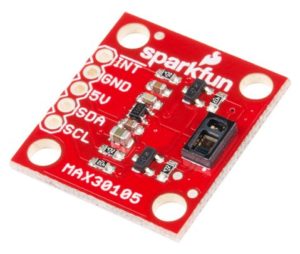
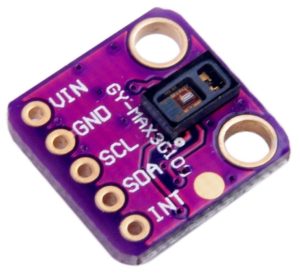
Questi sensori devono essere collegati con quattro fili che portano dati seriali di tipo I2C. Quindi invece che a un Master li collegheremo a un Arduino Nano come spiegato in questa pagina e in particolare nel file “Reading_I2C_Sensors”.
Si possono montare questi sensori su un piastrino mille-fori, nello stesso tubo di spugna isolante per i tubi del riscaldamento, come spiegato nella documentazione “Theremino_Pulsometer”. L’unica differenza è che si devono utilizzare quattro fili quindi non si potrà utilizzare un Jack per il collegamento. Si consiglia quindi di saldare i fili direttamente all’Arduino Nano, che è piccolo e può stare nel prolungamento posteriore dello stesso millefori che tiene il sensore.
Sensori commerciali
Chi non ha tempo e attrezzature adatte può acquistare il sensore su eBay o su Amazon. Esistono diversi modelli, alcuni vanno talmente male da essere del tutto inutili, altri funzionano in modo inaffidabile, in pratica ne esiste uno solo che va abbastanza bene da essere utilizzabile, si chiama Easy Pulse.
Piccoli sensori
Questi lasciateli proprio perdere. Alcuni in Internet hanno scritto che il migliore uso che se ne può fare è smontarli e recuperare i componenti per altri usi.
Ce ne sono anche altri con aspetto simile e con emettitore e sensore riuniti insieme, lasciate perdere pure loro. L’unico con il sensore e l’emettitore dalla stessa parte che funziona un po’ è quello di pulsesensor.com che si vede nella prossima immagine.
pulsesensor.com
Questo funziona solo con persone che non hanno la pressione bassa, solo con il dito indice e solo se lo si posiziona con precisione e non si fa troppa pressione sul polpastrello.
Tenere il dito fermo senza fare troppa pressione è difficile per cui i grafici vengono sempre dondolanti (con la linea di base non orizzontale).
EasyPulse
Questo è l’unico consigliabile, una buona scelta per chi vuole comprare un apparecchio completo e pronto all’uso, ma ha alcuni difetti.
Il primo difetto è il cavetto non schermato. A vederlo è un bellissimo cavetto schermato con il Jack dorato ma in realtà se lo si apre ci sono solo i fili interni e il rivestimento in plastica ma niente calza metallica.
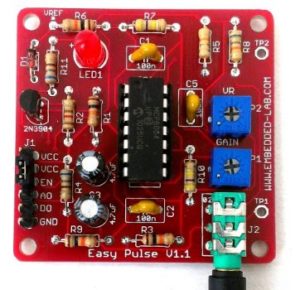
Il secondo difetto è il costo, dai 10 ai 15 Euro per il solo sensore e più del doppio per il sistema completo di sensore e modulo amplificatore.
Il modulo amplificatore funziona bene ma la sua banda passante è stata stretta appositamente a soli 3 Hz per eliminare i disturbi a frequenza di rete (50 o 60 Hz) prodotti dal cavetto non schermato.
A causa della banda passante stretta gli impulsi sono arrotondati e si perdono i particolari ad alta frequenza.
Per la ricerca delle aritmie la forma degli impulsi conta poco e quindi questo sensore potrebbe andare bene. Però dispiace perdere particolari della forma d’onda che potrebbero venire utili in futuro per fare ricerche. Vi sono ad esempio degli studi che dimostrano che si può misurare la elasticità delle arterie tramite la forma degli impulsi, ad esempio questo. Ma per queste misure la banda passante deve essere almeno di 15 o 20 Hz, altrimenti gli impulsi vengono troppo arrotondati.
Un ultimo piccolo difetto di questo sensore è che la ampiezza degli impulsi dipende dalla quantità di luce che passa attraverso il dito. Per cui persone con la pelle poco trasparente, le dita callose o con lo smalto alle unghie avranno un segnale più basso. Non è un grave difetto, solo una scomodità, basta ruotare un po’ il trimmer e il sensore funzionerà con tutte le persone.
Nel sensore da noi studiato questo problema è stato minimizzato illuminando il dito da davanti invece che da sopra e alimentando il fototransistor con un resistore da 470 k al posto che 10 k. Con un resistore di alto valore quando c’è molta luce il transistor va verso la saturazione e compensa automaticamente il maggiore segnale. Queste due differenze rendono il nostro sensore più stabile e quasi indipendente dalla persona, dal colore della pelle e dal dito che si usa.
Collegare il sensore EasyPulse al modulo Master
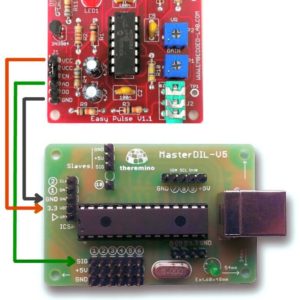
Per collegare il sensore EasyPulse al nostro sistema si deve utilizzare un cavetto Dupont a tre fili collegato a GND, AO e VCC.
Il cavetto va poi collegato al nostro modulo Master con:
- GND collegato a GND
- AO collegato al SIGNAL di un Pin a scelta
- VCC collegato al 3.3 volt
Cliccate sulla immagine per ingrandirla.
Il software
Il sensore EasyPulse può essere utilizzato con il suo software che si scarica da questa pagina. La sua applicazione non fa vedere nulla fino a che non le si inviano dati attraverso la seriale virtuale. Per inviarle dati si dovrebbe installare Processing e utilizzare una sua applicazione. Poi si dovrebbe anche programmare un Arduino con uno Sketch apposito. Per cui non abbiamo potuto provarla ma nella prossima sezione ci sono dei video che la fanno vedere.
In alternativa si può utilizzare il sensore EasyPulse con la nostra applicazione Theremino_ECG, lo abbiamo provato e funziona bene.
La nostra applicazione e quelle di Arduino
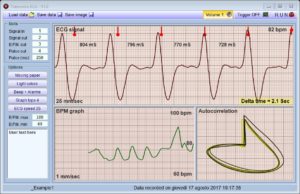 A causa della enorme popolarità di Arduino molti fanno confusione e scartano a priori il nostro sistema per il solo fatto che termina con “ino”.
A causa della enorme popolarità di Arduino molti fanno confusione e scartano a priori il nostro sistema per il solo fatto che termina con “ino”.
Per cui dobbiamo sfruttare ogni occasione per mostrare quali sono le differenze. Confrontate la applicazione Theremino_ECG con le applicazioni per Arduino.
Arduino è un micro-controllore programmabile mentre il nostro sistema è in gran parte costituito da software che gira su un PC. Arduino potrebbe funzionare anche da solo con un piccolo display ma in pratica per alimentarlo e visualizzare i dati si finisce per collegarlo a un PC.
Ma dato che Arduino è nato per poter fare a meno del PC il suo hardware è più complesso e collegarlo con il software sul PC è più difficile. Inoltre per far girare il software si deve installare Processing, Java o Phyton e i risultati finali sono notevolmente meno fluidi a causa del collegamento via seriale virtuale e della scarsa efficienza di quei linguaggi.
- YouTube video – EasyPulse e Arduino
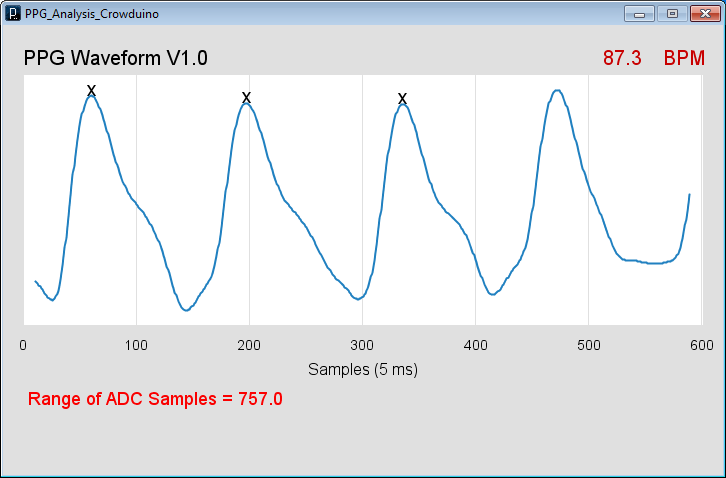
- YouTube video – Processing e Arduino
- YouTube video – Sensore ottico con Arduino
- YouTube video – Sensore ottico con Arduino
- YouTube video – Sensore ottico con Arduino
- YouTube video – Sensore ottico con Arduino
- YouTube video – Sensore ottico con Arduino
- YouTube video – Arduino e Android
Saturazione di ossigeno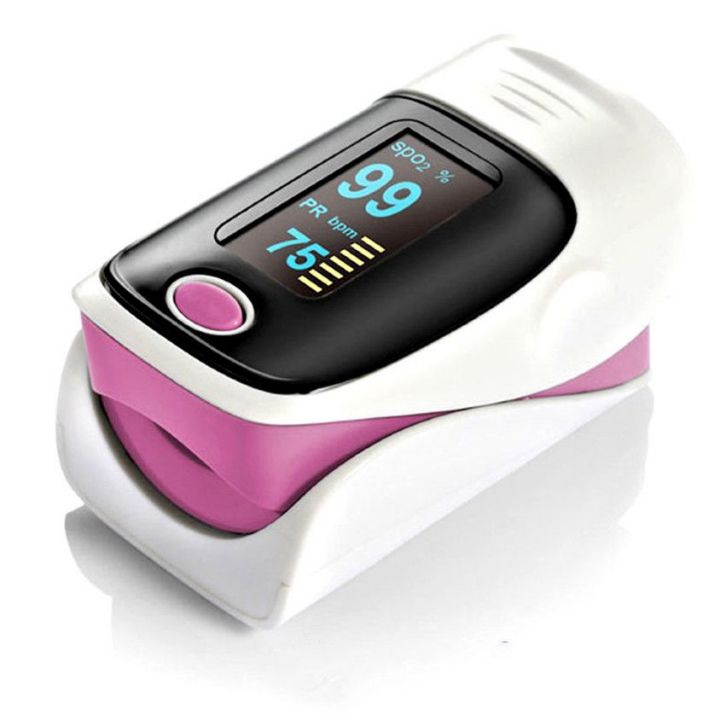
Abbiamo valutato se aggiungere anche la misura della saturazione e abbiamo deciso di concentrarci sulla sola ricerca delle aritmie. I motivi di questa decisione sono:
- Esistono comodi ed economici saturimetri da dito. Li si trovano su eBay o Amazon anche per meno di nove Euro con spedizione dall’Europa (spese postali e batterie comprese nel prezzo).
- Misurare la saturazione potrebbe essere utile solo in caso di patologie gravi. Normalmente la saturazione è sempre a posto e quando non lo fosse si è già a conoscenza del perché.
- Il circuito sarebbe complesso. Ci vorrebbero componenti particolari e tarature che renderebbero impossibile la auto-costruzione. In mancanza di queste accortezze la precisione diventerebbe così bassa da rendere le misure del tutto inutili.
- Ma quello che ci ha convinto maggiormente è la scarsa precisione dei misuratori commerciali. Il prossimo paragrafo parla delle loro caratteristiche.
Precisione dei saturimetri commerciali
Anche i migliori saturimetri commerciali dichiarano nelle loro stesse caratteristiche una precisione del +/- 2% nelle migliori condizioni e del +/- 3% quando il segnale è scarso o il paziente si muove.
Le letture sono ancora meno precise se:
– Si hanno le mani fredde;
– Si hanno problemi di circolazione;
– Si ha lo smalto alle unghie, o unghie artificiali;
– Quando i livelli di saturazione del sangue sono molto bassi;
– Quando si ha la pelle poco trasparente, scura o le dita spesse o callose;
– Se il sensore è troppo largo o troppo stretto;
– Se il paziente ha i brividi o soffre di crisi ricorrenti o di tremore;
– Se il paziente è afflitto da iperventilazione;
– Se la temperatura ambiente è particolarmente alta o bassa.
E si ottengono gravi errori sistematici nei seguenti casi:
– Un inadeguato flusso sanguigno può far leggere alti livelli di saturazione di ossigeno anche se il paziente sta avendo un caso di ipossia;
– Alti livelli di meta-emoglobina causano letture vicino allo 85%, indipendentemente dalla reale saturazione dell’ossigeno nel sangue.
Pertanto in alcuni casi gli errori potrebbero superare il +/- 5%. Quindi se per esempio la misura reale fosse del 95% si potrebbero leggere valori da 90% (grave ipossia) fino al 100 % (iperventilazione).
La tabella seguente mostra cosa vuol dire una imprecisione di misura che va dal 90% al 100%
- Il valore di 100% è sintomo di iperventilazione;
- Tra il 96% e il 99% sono considerati valori normali di O2;
- Tra il 95% e il 93% sono indicativi di una parziale assenza dell’ossigeno (lieve ipossia);
- Tra il 92% e il 90% sono indicativi di ossigenazione insufficiente;
- Valori al di sotto del 90% indicano una severa deficienza di ossigeno (grave ipossia).
La immagine seguente è tratta da uno studio approfondito su un gran numero di casi e mostra l’alto grado di variabilità delle misure effettuate con i saturimetri applicati su un dito.
La documentazione originale, che spiega anche come misurare la saturazione con tecniche precise ma invasive, si scarica da questa pagina.
Sensore per ECG
Questo è un elettrocardiogramma (prima derivazione) ottenuto con un modulo AD8232 (pochi Euro su eBay) collegato direttamente ad un ingresso Adc16 del modulo theremino Master.
Un particolare ringraziamento a Lodovico del PhysicsOpenLab che ci ha fatto conoscere questo modulo e ha fatto le prime sperimentazioni, inizialmente con l’Adc24 e poi, semplificando, è riuscito a ottenere ottimi risultati anche con il solo Master.
Il modulo AD8232 contiene un chip di “Analog Devices” espressamente progettato per gli elettrocardiografi e permette di ottenere tracciati puliti anche in ambienti elettricamente rumorosi.
La applicazione Theremino SignalScope, originalmente progettata come Oscilloscopio o come DataLogger è perfetta per memorizzare e visualizzare gli ECG. Si possono registrare i dati per un tempo molto lungo, anche ore o giorni. E poi si può scorrere all’indietro nel tempo e ingrandire moltissimo, fino a vedere i singoli campioni dell’Adc e dettagli di pochi millisecondi.
Il SignalScope dispone anche di due cursori per misurare tensioni tempi e frequenze.
La applicazione SignalScope si scarica da questa pagina.
Per configurare gli ingressi del Master e poi per leggerli durante il funzionamento si deve scaricare anche la applicazione HAL da questa pagina.
Ricordarsi che quando si comunica attraverso l’USB la applicazione HAL deve sempre essere attiva, magari minimizzata ma attiva. Leggere in questa pagina come creare cartelle “portable” e aprire e chiudere l’HAL e il SignalScope con un solo Click, senza doverli cercare e cliccare uno per uno.
Posizionare gli elettrodi
Non è necessario collegare il terzo elettrodo alla gamba destra come scritto in altre pubblicazioni. Si ottengono gli stessi risultati posizionandolo vicino all’elettrodo “L”.
La posizione degli elettrodi che si vede in questa immagine (chiamata “prima derivazione”) è quella che fornisce il segnale più forte e meno disturbato.
Gli elettrodi hanno un bottone metallico per collegarli ai connettori. Prima di applicare gli elettrodi alla pelle è importante pulirla con alcool, altrimenti resta una pellicola di grasso che è isolante.
Se gli elettrodi non fanno un buon contatto allora la linea di base del grafico non rimane ferma e dondola in alto e in basso con la respirazione e ad ogni minimo movimento del paziente. Per cui è importante seguire la procedura seguente:
1) Si agganciano i “pussoir”.
2) Si pulisce la pelle con alcool.
3) Si toglie la protezione e si incollano posizionandoli come da immagine
Importante seguire la sequenza e incastrare i “pussoir” prima di incollare gli elettrodi, altrimenti poi si preme troppo sulla pelle.
Collegamenti tra il modulo AD8232 e il modulo Master
Per il collegamento si può utilizzare un cavetto femmina femmina Dupont, da tre o da cinque fili.
Non è necessario collegare i segnali LO- e LO+
Collegandoli si potrebbe avere anche l’informazione che i due elettrodi sono applicati sul paziente.
Per collegarli si userebbe un cavetto femmina femmina Dupont, da cinque fili e si collegherebbero agli ingressi del segnale dei Pin 2 e 3, come nella tabella seguente:
LO- ---> SIG Pin2 LO+ ---> SIG Pin3
Impostazione degli ingressi
Per impostare gli ingressi del modulo Master si utilizza la applicazione HAL.
====================================== Impostazione Master ====================================== Master Comm. speed = 10, 11 o 12 -------------------------------------- Impostazione Pin 1 -------------------------------------- PinType = Adc16 Response speed = 100 Pulsante Response Speed NON premuto -------------------------------------- Impostazione Pin 2 -------------------------------------- PinType = DigIn Response speed = 100 Pulsante Response Speed NON premuto -------------------------------------- Impostazione Pin 3 -------------------------------------- PinType = DigIn Response speed = 100 Pulsante Response Speed NON premuto
Altri sensori biometrici
Per ora tutto il (poco) materiale relativo è nel Blog: https://www.theremino.com/blog/biometry

